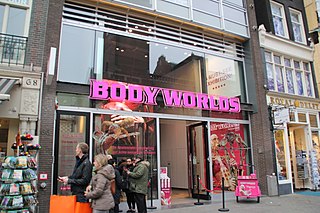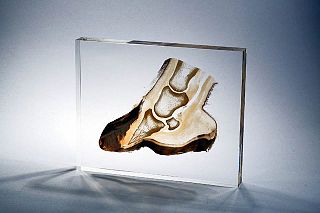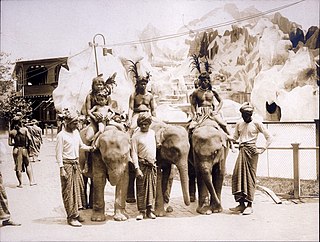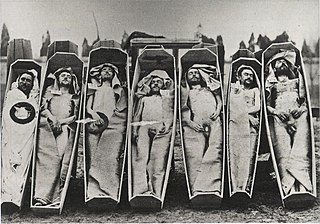
A mummy is a dead human or an animal whose soft tissues and organs have been preserved by either intentional or accidental exposure to chemicals, extreme cold, very low humidity, or lack of air, so that the recovered body does not decay further if kept in cool and dry conditions. Some authorities restrict the use of the term to bodies deliberately embalmed with chemicals, but the use of the word to cover accidentally desiccated bodies goes back to at least the early 17th century.

Body Worlds is a traveling exposition of dissected human bodies, animals, and other anatomical structures of the body that have been preserved through the process of plastination. Gunther von Hagens developed the preservation process which "unite[s] subtle anatomy and modern polymer chemistry", in the late 1970s.
The abortion debate is a longstanding, ongoing controversy that touches on the moral, legal, medical, and religious aspects of induced abortion. In English-speaking countries, the debate most visibly polarizes around adherents of the self-described "pro-choice" and "pro-life" movements. Pro-choice emphasizes a woman's right to bodily autonomy, while the pro-life position argues that a fetus is a human deserving of legal protection, separate from the will of the mother. Both terms are considered loaded in mainstream media, where terms such as "abortion rights" or "anti-abortion" are generally preferred.

Plastination is a technique or process used in anatomy to preserve bodies or body parts, first developed by Gunther von Hagens in 1977. The water and fat are replaced by certain plastics, yielding specimens that can be touched, do not smell or decay, and even retain most properties of the original sample.

The Ontario Science Centre, is a science museum in Toronto, Ontario, Canada. It is located near the Don Valley Parkway about 11 kilometres (6.8 mi) northeast of downtown on Don Mills Road in the former city of North York. It is built down the side of a wooded ravine formed by one branch of the Don River located in Flemingdon Park.
Zhu Yu is a performance artist and alleged cannibal living in Beijing, China. Zhu graduated from the Affiliated High School of the China Central Academy of Fine Arts in 1991. His work deals with subjects of contemporary art.

Human zoos, also known as ethnological expositions, were public displays of people, usually in a so-called "natural" or "primitive" state. They were most prominent during the 19th and 20th centuries. These displays sometimes emphasized the supposed inferiority of the exhibits' culture, and implied the superiority of "Western society", through tropes that purported marginalized groups as "savage". The idea of a "savage" derives from Columbus's voyages that deemed European culture remained pure, while other cultures were titled impure or "wild", and this stereotype relies heavily on the idea that different ways of living were "cast out by God", as other cultures do not recognize Christianity in relation to Creation. Throughout their existence such exhibitions garnered controversy over their demeaning, derogatory, and dehumanizing nature. They began as a part of circuses and "freak shows" which displayed exotic humans in a manner akin to a caricature which exaggerated their differences. They then developed into independent displays emphasizing the exhibits' inferiority to western culture and providing further justification for their subjugation. Such displays featured in multiple colonial exhibitions and at temporary exhibitions in animal zoos.
Dalian Medical University is a university in Dalian, Liaoning, China under the provincial government. It was founded in 1947.
Murder for body parts also known as medicine murder refers to the killing of a human being in order to excise body parts to use as medicine or purposes in witchcraft. Medicine murder is viewed as the obtaining of an item or items from a corpse to be used in traditional medicine. Its practice occurs primarily in sub-equatorial Africa.

A cadaver or corpse is a dead human body. Cadavers are used by medical students, physicians and other scientists to study anatomy, identify disease sites, determine causes of death, and provide tissue to repair a defect in a living human being. Students in medical school study and dissect cadavers as a part of their education. Others who study cadavers include archaeologists and arts students. In addition, a cadaver may be used in the development and evaluation of surgical instruments.

The Soviet Paradise was the name of an exhibition and a propaganda film created by the Department of Film of the propaganda organisation (Reichspropagandaleitung) of the German Nazi Party (NSDAP), and was displayed in the larger cities of the Reich and occupied countries: Vienna, Prague, Berlin and others. Its goal was to show "poverty, misery, depravity and need" of the nations in the Soviet Union under "Jewish Bolshevist" rule and thus to justify the war against the Soviet Union. The accompanying guide for the exhibition noted, "The present Soviet state is nothing other than the realization of that Jewish invention".

Boeing Galleries are a pair of outdoor exhibition spaces within Millennium Park in the Loop community area of Chicago in Cook County, Illinois, United States. The spaces are located along the south and north mid-level terraces, above and east of Wrigley Square and the Crown Fountain. In a conference at the Chicago Cultural Center, Boeing President and Chief Executive Officer James Bell to Chicago Mayor Richard M. Daley announced Boeing would make a $5 million grant to fund both the construction of and an endowment for the space.
A prosection is the dissection of a cadaver or part of a cadaver by an experienced anatomist in order to demonstrate for students anatomic structure. In a dissection, students learn by doing; in a prosection, students learn by either observing a dissection being performed by an experienced anatomist or examining a specimen that has already been dissected by an experienced anatomist
A fetus or foetus is the unborn offspring that develops from an animal embryo. Following embryonic development the fetal stage of development takes place. In human prenatal development, fetal development begins from the ninth week after fertilization and continues until birth. Prenatal development is a continuum, with no clear defining feature distinguishing an embryo from a fetus. However, a fetus is characterized by the presence of all the major body organs, though they will not yet be fully developed and functional and some not yet situated in their final anatomical location.

SalāLemi Ponifasio is a prolific international theatre director, choreographer, and artist. He is known for his radical approach to theatre, dance, art and activism, and for his collaboration with communities.

Gunther von Hagens is a German anatomist, businessman and lecturer. He developed the technique for preserving biological tissue specimens called plastination. Von Hagens has organized numerous Body Worlds public exhibitions and occasional live demonstrations of his and his colleagues' work, and has traveled worldwide to promote its educational value. The sourcing of biological specimens for and the commercial background of his exhibits has been controversial.

Premier Exhibitions Inc is an Atlanta, Georgia-based company that organizes traveling exhibitions. As of January 2019, the company owned 5,500 Titanic relics with approximately 1,300 on display in various countries.
A beating heart cadaver is a body that is pronounced dead in all medical and legal definitions, connected to a medical ventilator, and retains cardio-pulmonary functions. This keeps the organs of the body, including the heart, functioning and alive. As a result, the period of time in which the organs may be used for transplantation is extended. The heart contains pacemaker cells that will cause it to continue beating even when a patient is brain-dead. Other organs in the body do not have this capability and need the brain to be functioning to send signals to the organs to carry out their functions. A beating heart cadaver requires a ventilator to provide oxygen to its blood, but the heart will continue to beat on its own even in the absence of brain activity. This allows organs to be preserved for a longer period of time in the case of a transplant or donation. A small number of cases in recent years indicate that it can also be implemented for a brain-dead pregnant woman to reach the full term of her pregnancy. There is an advantage to beating heart cadaver organ donation because doctors are able to see the vitals of the organs and tell if they are stable and functioning before transplanting to an ailing patient. This is not possible in a donation from someone pronounced dead.
Allegations of forced organ harvesting from Falun Gong practitioners and other political prisoners in China have raised concern within the international community. According to a report by former lawmaker David Kilgour, human rights lawyer David Matas and journalist Ethan Gutmann of the Victims of Communism Memorial Foundation, political prisoners, mainly Falun Gong practitioners, are being executed "on demand" in order to provide organs for transplant to recipients. Reports have said that organ harvesting has been used to advance the Chinese Communist Party's persecution of Falun Gong and because of the financial incentives available to the institutions and individuals involved in the trade. A report by The Washington Post has disputed some of the allegations, saying that China does not import sufficient quantities of immunosuppressant drugs, used by transplant recipients, to carry out such quantities of organ harvesting.

Katja Loher is a Swiss visual artist, known for her video sculptures and installations. She often integrates organic, planetary, and moving choreographic elements into panoramic aerial perspectives. Her pieces are considered by critics as evocative of alternative dimensions where past, present, and future converge. Her works have been shown in art museums in many countries including Italy, Russia, China, and the US. Her art is also represented in the collections of institutions like Swissgrid AG, Perth Concert Hall Museum, and the New Britain Museum of American Art. Loher was born in Zurich in 1979.












